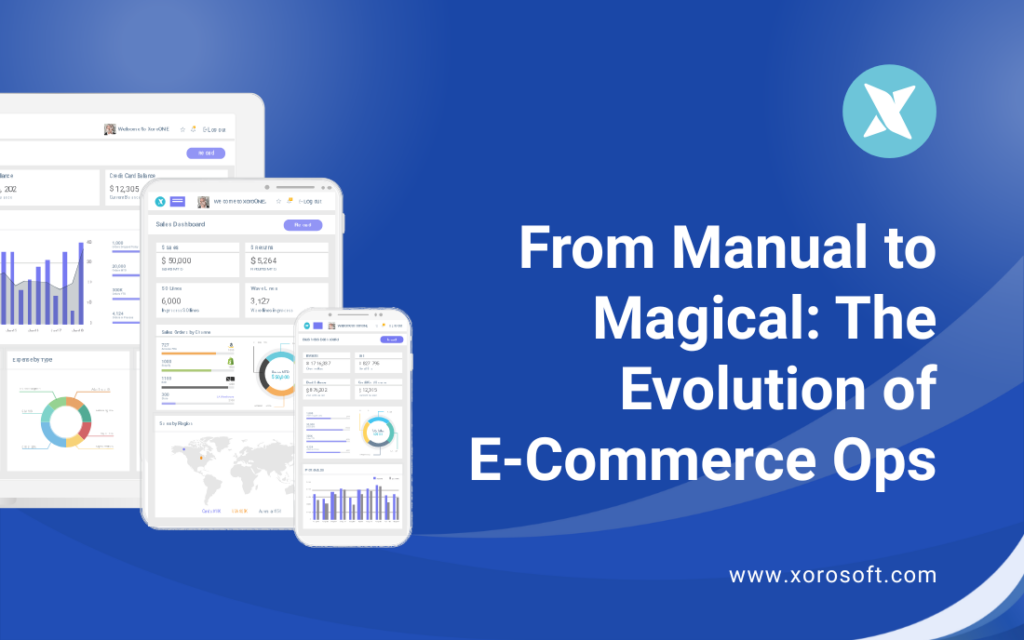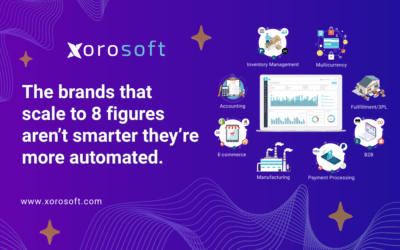
Ecommerce Workflow Platform: From Manual to Magical
Running an online brand should feel creative, not chaotic. Yet for many founders, operations still depend on scattered spreadsheets and disconnected tools. That’s why adopting an ecommerce workflow platform is becoming essential. It unifies your systems, automates routine tasks, and provides visibility across your entire operation. As a result, brands can scale confidently while focusing on growth rather than firefighting.
Why Growing Brands Need an Ecommerce Workflow Platform
When your brand is small, managing orders, inventory, and accounting manually might seem efficient. However, as your product range and order volume expand, complexity grows faster than your team can keep up. Eventually, the cracks start to show.
Here are some familiar warning signs:
-
Inventory confusion: Shopify says one thing, your warehouse says another.
-
Data silos: Sales, purchasing, and finance each use different tools.
-
Slow fulfillment: Orders wait in queues because systems aren’t talking.
-
Inconsistent reports: Finance and operations see different numbers.
-
Time wasted: Teams duplicate work just to stay aligned.
These problems create constant stress. Consequently, energy that could drive growth instead goes into firefighting. This is exactly where an ecommerce workflow platform changes everything. By connecting all your moving parts into one system, you can finally operate with clarity.
The Turning Point: When Manual Work Stops Working
Every fast-growing ecommerce brand eventually hits a breaking point. At first, new sales channels and wholesale orders seem manageable. Soon after, multiple warehouses stretch old processes too far. Therefore, what used to work starts costing both time and money.
At this stage, patching together more apps doesn’t help. Instead, it creates new data gaps and delays. An ecommerce workflow platform solves this problem by becoming your operational hub. It connects orders, inventory, accounting, and fulfillment automatically, ensuring that every team works from the same live data.
As a result, leaders gain confidence. Teams stop chasing spreadsheets. Furthermore, the business finally runs on accurate, real-time information.
How an Ecommerce Workflow Platform Transforms Operations
A connected back-office isn’t just about automation; rather, it’s about alignment. The right ecommerce workflow platform turns data into a shared language between your teams. In addition, it reduces errors, improves collaboration, and accelerates decision-making. Here’s how it makes a measurable impact.
1. Unify Data Across Every Channel
Goal: Create one source of truth for your operations.
Action: Connect Shopify, your warehouse, and accounting software into a single ecosystem.
Metric: Zero manual syncs or mismatched reports.
When data flows automatically between platforms, accuracy improves immediately. Moreover, leadership can make confident decisions without waiting for manual updates. Because of this, your team can act on information instead of chasing it.
2. Automate Order Fulfillment
Goal: Speed up the order-to-delivery cycle.
Action: Use your ecommerce workflow platform to integrate with your 3PL or WMS.
Metric: 30% faster fulfillment time.
As orders sync automatically, warehouse teams receive clear, real-time instructions. Consequently, fulfillment errors drop, and customers get products faster. Additionally, your customer service team spends less time resolving issues and more time improving the experience. In other words, efficiency and satisfaction rise together.
3. Improve Demand Forecasting
Goal: Predict demand more accurately.
Action: Combine live sales and inventory data inside the workflow platform.
Metric: 10% less excess inventory.
When your system connects every channel, forecasting shifts from reactive to proactive. As a result, you avoid costly stockouts and overstocking. Therefore, planning becomes consistent and data-driven. For example, your purchasing team knows exactly when to reorder and how much stock to hold.
4. Strengthen Financial Visibility
Goal: See cash flow clearly and continuously.
Action: Link your accounting software directly with the ecommerce workflow platform.
Metric: 20% faster cash conversion cycle.
Because invoices, payments, and purchase orders sync automatically, your finance team knows where every dollar is. Consequently, cash planning becomes smoother, and reporting happens in real time instead of month-end chaos. Furthermore, stakeholders gain the transparency they expect from a modern ecommerce operation.
5. Empower Teams to Work Smarter, Not Harder
Goal: Reduce repetitive manual work.
Action: Replace spreadsheet-based tasks with automated workflows.
Metric: Save at least five hours per day per operations manager.
Automation frees up your team to focus on high-value activities such as process optimization, supplier relations, and customer engagement. In addition, fewer manual tasks reduce human error and create a calmer, more organized workday. Meanwhile, morale improves as employees spend more time on meaningful work.
6. Standardize Reporting and Improve Transparency
Goal: Give leadership a real-time view of performance.
Action: Use the dashboard capabilities of your ecommerce workflow platform.
Metric: Live accuracy across inventory, orders, and finances.
Now, everyone can see the same metrics at the same time. As a result, accountability increases naturally. Moreover, automated dashboards replace the weekly scramble for reports, leading to faster, better decisions across departments. Ultimately, clarity becomes your competitive edge.
How a DTC Brand Scaled With an Ecommerce Workflow Platform
A DTC apparel company earning $4.5M in annual revenue was struggling with manual order tracking and mismatched reports. Each week, the operations team spent hours reconciling spreadsheets between Shopify and their warehouse. Eventually, errors began to affect customer satisfaction.
After switching to an ecommerce workflow platform, they saw immediate gains:
-
Order accuracy increased by 25%.
-
Fulfillment speed improved by 35%.
-
Cash conversion cycle shortened by 18%.
-
Ops team saved around 20 hours per week.
Because of these improvements, leadership was able to refocus on product development and expansion rather than operational troubleshooting. In short, automation gave them back control.
A 10-Day Plan to Implement Your Ecommerce Workflow Platform
Transforming your operations doesn’t need to feel overwhelming. In fact, following a short, structured plan helps your team adapt smoothly and confidently.
| Day | Focus Area | Outcome |
|---|---|---|
| 1–2 | Audit all systems (Shopify, 3PL, accounting) | Identify integration points |
| 3–4 | Standardize SKUs and product naming | Prevent data mismatches |
| 5 | Connect ecommerce store to the workflow platform | Validate sync accuracy |
| 6–7 | Integrate fulfillment and accounting systems | Build a unified data flow |
| 8 | Automate routine workflows | Reduce manual touchpoints |
| 9 | Create performance dashboards | Gain instant visibility |
| 10 | Train your teams and review success metrics | Ensure adoption and efficiency |
By the end of ten days, your ecommerce workflow platform becomes the single operational source of truth, streamlining the entire business. Afterward, your team can focus on continuous improvement rather than setup tasks.
Common Questions From Founders and COOs
How long until we see results?
Most brands notice faster fulfillment and reduced manual work within 30–45 days after implementation. Therefore, ROI appears sooner than expected.
Will this replace my accounting or warehouse tools?
No. The ecommerce workflow platform enhances your existing stack by syncing data between systems. In this way, it complements what you already use.
Do I need a technical team to manage it?
Not at all. Modern platforms are intuitive and require no coding. Moreover, support teams guide you through setup.
How can I measure success?
Track key operational metrics: pick accuracy, order cycle time, and cash conversion. If these improve, your system is working effectively.
How an Ecommerce Workflow Platform Drives Sustainable Growth
Once your workflows are automated, efficiency compounds over time. Because of that, every department moves in sync with clear visibility. Additionally, leadership gains confidence knowing that data is current and consistent.
Investing in an ecommerce workflow platform isn’t only about saving time—it’s about building a scalable foundation. Furthermore, it transforms operations into a strategic advantage instead of a daily struggle. Eventually, brands that adopt it early will outperform those still trapped in manual cycles.
Explore the Best Tools for E-Commerce Workflow Integration
To find a trusted platform, start here:
Together, these tools simplify complex ecommerce operations and integrate seamlessly with Shopify. Therefore, your team can manage fulfillment, finance, and reporting without juggling multiple apps.
Final Thoughts
Growth no longer requires chaos. With a well-implemented ecommerce workflow platform, your brand can operate with confidence, accuracy, and speed. Consequently, every team—from fulfillment to finance—works from the same playbook.
Ultimately, the shift from manual to magical isn’t about technology alone. Instead, it’s about freeing your business to grow the way you imagined from day one. Finally, calm, connected operations become the new normal.









